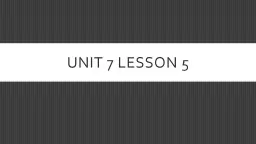

5 Learning Objective Student will be able to discuss urban sprawl gentrification and movement from CBD Where we left off Central Business District Expensive land Used primarily for business purposes ID: 508342
Download Presentation The PPT/PDF document "Unit 7 Lesson" is the property of its rightful owner. Permission is granted to download and print the materials on this web site for personal, non-commercial use only, and to display it on your personal computer provided you do not modify the materials and that you retain all copyright notices contained in the materials. By downloading content from our website, you accept the terms of this agreement.
Slide1
Unit 7 Lesson 5Slide2
Learning Objective
Student will be able to discuss urban sprawl, gentrification, and movement from CBDSlide3
Where we left off…
Central Business District
Expensive land
Used primarily for business purposes
Then in the 1960’s….
People really started to move away (think Pruitt-
Igoe
)
So the CBD still has businesses, but not to the extent before
Large cities still have very desirable land-use for this area, but mostly for corporate buildingsSlide4
Where did everyone go? (1960’s & early 1970’s)
1
st
: Who is everyone? (People wealthy enough to have cars)
2
nd
: Succession occurs
When one population moves from an area, another moves in…so in the city the “wealthy areas” become inhabited by middle-class, middle-class areas inhabited by low-income earners…low-income earner areas typically then become immigrant areas.
Wealthy people first move to the suburbs
Middle-Class then follows
Leads to “Urban Decay” (Pruitt-
Igoe
)Slide5
Density Gradient
-It’s impossible to see this picture unless it’s on your computer, even then you might need to adjust it.
-This shows the “Density Gradient” of Chicago in 1900 and how it changes to 1990
-Density Gradient is about how many people live per-square hectare. As the population becomes more mobile, the population spreads further out from CBD. Slide6
Urban Sprawl
Sprawl: “the progressive spread of development over the landscape.”
New developers who build suburbs will seek out cheap land
Typically not contiguous to existing built-up land (which would be more expensive)
Creates pockets or gaps in cities because developers will often leave vacant areas
Roads and utilities most extend to connect new developments
Wastes landSlide7
U.K. and a few cities in U.S. will have a “Green Belt”, nothing can be developed in that area; forcing more concentration and less sprawling. Slide8
Let’s go to the City! (2000’s)
Urban renewal
Younger business professionals find the CBD and central city areas attractive places
Urban renewal projects often specifically targeted this group by building up night-life and/or public transportation
People are moving back to the city (typically people without families)
Detropia
; remember the artist talking about the cheap housing? Slide9
Hooray! Gentrification
Businesses/housing want to attract the younger/more affluent customer so build up specifically for that person
Areas that were previously “blighted” are invested in and renovated to attract the people moving back to the city.
Increase tax base, bring in more money for services
Drive-up the overall value of an area
gentrification
When you walk out the front door of school today; look up, see the construction, this is gentrification.
Slide10
Oh-No! Gentrification.
More people want to live in the area (drive up demand)
Increased rents (remember, lower socio-economic more renters)
Increased cost of housing
Increased cost of housing leads to an increase in property values
Even if a person does not want to sell their property taxes go up.
Property taxes are the amount a person owes EVERY year; regardless if they own their house
Higher property taxes means that people are forced out
House is sold for cheap b/c it’s a “tear-down” only the land is being bought